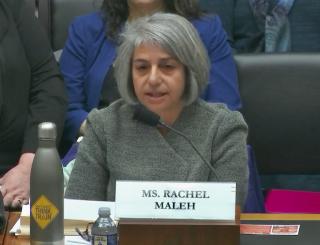Testimony of Operation Lifesaver, Inc. before the House Railroad Subcommittee on February 5, 2020
View and download the full OLI testimony
Statement
Chairman Lipinski, Ranking Member Crawford, and Members of the Subcommittee, thank you for inviting me to testify about Operation Lifesaver, Inc.’s ongoing work to save lives at grade crossings and along rights of way. My name is Rachel Maleh, and I have been Executive Director of this organization since November of 2018.
Operation Lifesaver started in 1972 in Idaho and quickly expanded to other states around the U.S. The National Office of Operation Lifesaver, Inc., was established in 1986.
OLI is the only nationally recognized nonprofit leader of rail safety education. Our mission is to save lives by empowering the public to make safer choices near tracks and trains. We do this through a network of active state programs across the country and through public education and awareness campaigns.
Our safety partners include federal, state and local government agencies, highway safety organizations, America’s railroads and railway suppliers. Together, we promote the three E's - Education, Enforcement and Engineering - to keep people safe around tracks and grade crossings across the country.
OLI’s funding comes from federal partners, private sector contributors, including Class I railroads and railway suppliers, and foundation grants. About 64% of our funding is from federal resources, private partners account for 31%, and foundation grants contribute 5%.
The heart of Operation Lifesaver is its grassroots network of state program directors and volunteers in 45 states and the District of Columbia. Our volunteers are out in their communities every day. We educate people about how to safely navigate grade crossings, and to never use train tracks as a short cut or pathway. Our 2018 annual report shows that 1.6 million people were reached directly across the U.S. in over 20,000 Operation Lifesaver presentations, training classes and events.
Allthese outreach efforts are free of charge and given in the interest of safety.
Our primary federal partners are the Federal Railroad Administration (FRA), Federal Highway Administration (FHWA), and Federal Transit Administration (FTA).
One of the most visible results of our federal partnerships are the competitive rail safety grants that OLI awards to state Operation Lifesaver programs, commuter railroads and rail transit agencies. For example, in 2019 OLI used FRA funding to award rail safety grants through a competitive process to 13 state programs, including states that rank among the top 15 for grade crossing and trespass incidents. Last year, OLI used FTA funding to award competitive rail transit safety grants to 10 agencies in eight states. This federal funding truly is making a difference in communities across the nation.
Our private grant funding from the Posner Foundation of Pittsburgh allows us to extend the reach of these federally funded projects.
While we’ve made great strides in reducing crossing collisions – which have fallen by 82 percent since 1972 – it’s still a startling fact that about every three hours in the U.S., a person or vehicle is hit by a train. That’s why Operation Lifesaver’s rail safety education mission is still important today.
One example of how Operation Lifesaver’s public awareness efforts are making a difference is Rail Safety Week (RSW), held each year during the last week of September. This year, Rail Safety Week will take place Monday, September 21 through Sunday, September 27, in the U.S., Canada and Mexico, making it truly a North American effort.
Our Rail Safety Week efforts across the U.S. are having an impact in increased news coverage and social media engagement, further spreading our rail safety messages.
OLI’s efforts act as a force multiplier, leveraging federal funds for greater impact. Since 2017, we have awarded a total of 29 FRA Competitive State Grant funds of more than four hundred thousand dollars ($406,000), with a return of more than $1.4 million to states and communities.
In the Chicago area, OLI is partnering with the FRA on a trespass prevention education project in Cook County to see how a targeted campaign with our “Near Miss – Headphones” PSA affects the behavior of a young male demographic. Illinois Operation Lifesaver also works closely with Metra Commuter rail on education outreach.
Our “Find the Blue and White” Emergency Notification System Sign PSA campaign (hold up poster or indicate image on screen), shows drivers what to do if they get stuck on the tracks at a grade crossing. This PSA is being distributed nationally through a digital and broadcast ad campaign.
Each time a potentially catastrophic incident at a crossing is prevented, lives are saved, injuries are avoided, and communities are safer – this is Operation lifesaver’s impact.
If Operation Lifesaver were fortunate enough to receive additional funds from federal sources, we could expand the successful federal state grants and develop additional campaigns and resources for our state programs.
On behalf of Operation Lifesaver, I am grateful to our federal, state and local government safety partners, as well our private contributors, for your continued support.
We hope you will learn more, and join our safety effort, at oli.org.
###
